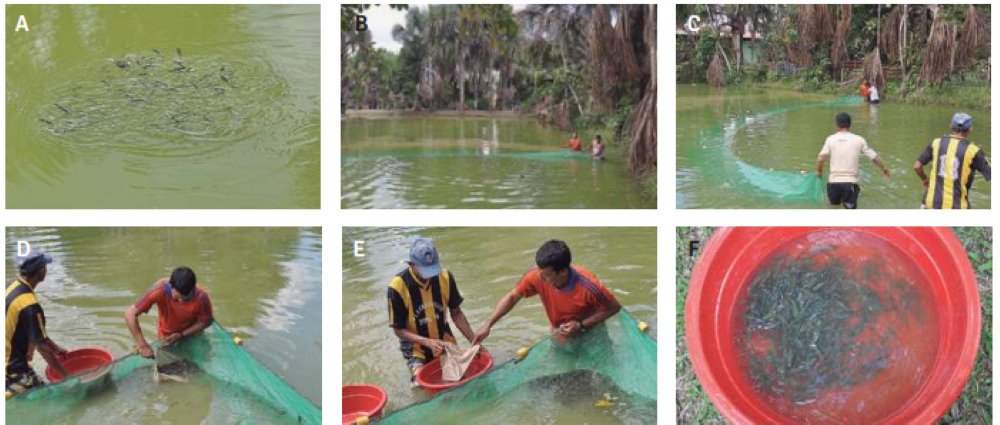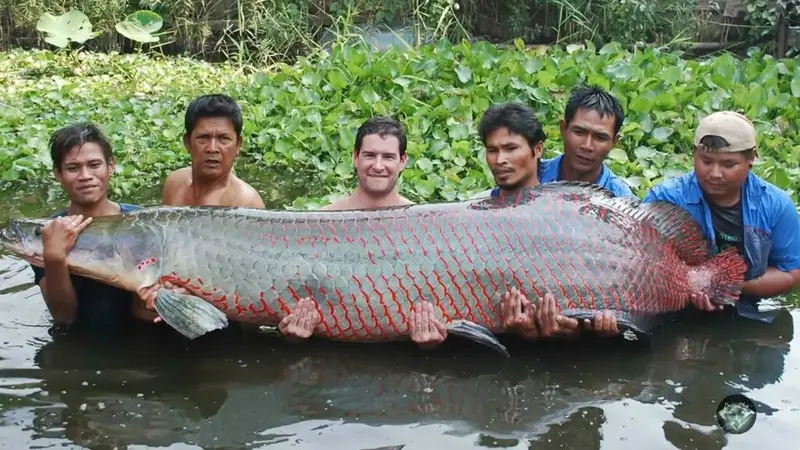In the last ten years, scientific research has enhanced our knowledge of the Peruvian Amazon, particularly regarding paiche farming in Peru and its fisheries, which play a key role in the population’s diet. The high demand for paiche meat in the past century brought the species to a critical conservation state. People value paiche for its fast growth and high-quality meat, as well as its skin and scale by-products, which make it a species with great potential for aquaculture.

Farming paiche in captivity provides a viable environmental, economic, and social alternative by reducing pressure on natural populations and generating employment. Paiche farming in Peru and fishing practices have proven to be sustainable strategies. This document, resulting from collaboration between IIAP and the Regional Government of Loreto, establishes a solid foundation for the sustainable development of aquaculture in the Peruvian Amazon.
SPECIES CHARACTERISTICS

TAXONOMIC ASPECTS
According to recent scientific advances, paiche (Arapaima gigas) stands as one of five recognized species of tropical freshwater fish in the Arapaimidae family. Until five years ago, experts knew only two species in this family: Heterotis niloticus in Africa and Arapaima gigas in South America. However, new studies have identified four species in the Arapaima genus: A. gigas, A. agassizii, A. mapae, and A. leptosoma. Researchers are still working to confirm a possible fifth species, A. arapaima.
ECOLOGY AND DISTRIBUTION
Paiche naturally inhabits the Amazon basin in countries such as Brazil, Peru, and Colombia. It also lives in the rivers of Guyana. In Peru, paiche occupies the lower basins of rivers like the Ucayali, Marañón, and Putumayo. The largest populations thrive in the Pacaya-Samiria National Reserve. Paiche farming and fishing have expanded to other regions of Peru, thanks to the species’ adaptability, which has boosted its presence in the international market.
BIOLOGICAL ASPECTS
Paiche carries its sexual organs on the left side of its abdominal cavity. Females possess a single functional ovary, while males have a single functional testicle. Reproduction occurs year-round in natural environments but intensifies during the rainy season. Studies conducted in the Pacaya Samiria National Reserve in Peru show that spawning reaches its peak between September and December. In the Mamirauá Reserve in Brazil, reproduction primarily takes place between December and May.
Paiche exhibits complex reproductive behavior. The fish form pairs, defend their territory, and build nests in shallow, vegetation-free shores. These nests measure between 15 and 20 cm deep and up to 60 cm in diameter. The male protects the eggs, larvae, and fry for about three months. Newly hatched fry swim close to the father’s head.
GENETIC ASPECTS
Natural paiche populations in the Peruvian Amazon display significant genetic differentiation. These populations evolve in distinct ways and may respond differently to the same environmental conditions. Crossing individuals from different populations can alter the genome and reduce their adaptive capacities, which would harm the fry’s ability to survive in their natural environment.
For this reason, it is not advisable to transfer specimens from one distant basin to another. Animals in those areas would lack the necessary adaptation. Introducing individuals from other regions or those raised in captivity can reduce the survival of native populations. When repopulating a diminished population, respecting the local gene pool and using genetically similar individuals becomes essential. Otherwise, this could harm natural populations and the ecosystem, making repopulation efforts ineffective.
PAICHE MANAGEMENT AND FARMING

BACKGROUND ON PAICHE FARMING
In the mid-19th century, people made salted-dried paiche their main source of protein in the Amazon. In the 20th century, paiche fishing became more important as the populations of other resources, such as manatees and aquatic turtles, declined. Starting in the 1980s, paiche farming in Peru, along with sustainable fishing, shifted from a basic food source to an expensive delicacy, which led to its inclusion in CITES Appendix II due to the risk of extinction.
Paiche has shown great potential for fish farming because of its hardiness and high market value. It also performs well under controlled conditions. On average, a female produces about 1,500 fry per spawning. Paiche can reach between 8 and 12 kg per year, with a fillet yield of 52%. Paiche fishing and farming in Peru have generated growing demand in international markets, solidifying them as key practices for conserving the species and reducing pressure on natural populations.

INFRASTRUCTURE FOR PAICHE FARMING
Paiche farmers in Peru use different infrastructures depending on the development stage. Farmers commonly use earthen ponds for fattening and reproduction phases. Although less frequent due to their cost, recirculation systems are employed in the nursery and fattening stages. Sustainable initiatives in the country have transformed paiche farming and fishing into an important economic driver, generating jobs and promoting food security in the Amazon region.
BREEDERS
Farmers use ponds ranging from 300 to 1,500 m² for paiche farming. Recently, breeders have opted to identify and separate pairs into areas of 300 to 500 m², which facilitates fry capture. It is advisable to construct ponds in clayey soils near a water source that allows for gravity-fed water renewal.

The ideal depth for adult fish ponds should range from 1.2 to 1.5 meters. In addition, the drainage system should draw water from the deepest levels, as this water generally contains less oxygen and accumulates toxic substances.
NURSERY
Farmers can handle fry from breeding ponds using various systems, including wooden tanks lined with plastic, glass aquariums, portable or inflatable pools, and fiberglass or concrete tanks with capacities ranging from 50 to 2,000 liters. It is important to provide optimal conditions so the fish can quickly adapt to balanced feed.
For easier management of the farm, farmers should install a water inflow and outflow system that allows for quick water renewal during this stage.
CAPTIVE BREEDING
Although paiche can reproduce in earthen ponds under semi-natural conditions, experts have only recently clarified the environmental and management factors that facilitate this process. The lack of knowledge about these key aspects caused fluctuations in supply and high costs for fry and juveniles for fattening. Reproduction plays a crucial role in the success of paiche farming. This section provides a step-by-step guide based on recent information from IIAP and private breeders.

Farmers select breeders according to the species. Understanding their biological and genetic characteristics, such as life cycle, age at first reproduction, and whether they are migratory, helps make appropriate decisions when selecting breeders. In migratory species like gamitana and pacu, which maintain constant genetic flow, breeders must pay attention to genetic variability to avoid inbreeding.
BREEDER MANAGEMENT
Working with fish that exceed 60 kg and reach 1.8 meters in length presents challenges. Although paiche proves resilient, proper handling during transport, pair separation, tagging, sexing, biometric control, and health management is essential. For these tasks, operators must have the appropriate materials prepared, which vary depending on the objective. In Iquitos, breeders use mesh hammocks for short transport and canvas stretchers for vehicle transport.
For blood extractions or chip tagging, operators place the fish on a wooden bed with a damp mattress. They keep the fish moist with pond water and cover its eyes with a damp cloth to calm it. Since adult paiche breathe mainly air and may jump during capture. Handling them with care ensures their well-being and the safety of the operators.

Sport fishing in Iquitos 4 days
MORE INFORMATION HERE




